Gouramis are an extremely popular fish that’s often seen in home community tanks.
There are 133 known species of these gorgeous fish, many of which you can buy from your local fish store, although more unusual, rarer species can be found for sale online from specialist breeders.
In this guide, we introduce you to 20 of the most popular species of gourami that you can keep in a community tank.
What Are Gouramis?
Before we dive into our list of 20 gourami species, let’s find out more about these beautiful fish.
The gourami belongs to several groups, including the Osphronemidae, Helostramoatidae, and Anabantidae families of fish.
Gouramis, like betta fish, are labyrinth breathers. The labyrinth organ has evolved to enable the fish to breathe atmospheric air at the water’s surface instead of relying solely on what dissolved oxygen the fish can extract from the water.
Gourami Lifespan and Size
Gouramis range in size from a few inches long to a foot or slightly more.
Most species of gouramis live for between four and five years, although some species can survive for much longer if kept in optimum conditions and fed a high-quality, correct diet.
Where Do Gouramis Come From?
Gouramis are found in southern and eastern Asia, ranging across Pakistan, Thailand, Vietnam, the Malaysian Archipelago, and China, extending north to Korea and Japan.
Thanks to their labyrinth organs, gourami fish and bettas can live in slow-moving waters, such as canals, swamps, marshes, and rice paddies, in relatively poor water conditions where the levels of dissolved oxygen are low.
Gourami Diet
Most species of gouramis are omnivores, eating a wild diet of insects, insect larvae, fish eggs, algae, and some plant matter.
Captive gouramis do well on a diet of high-quality tropical fish flakes, frozen meaty foods, and pellets.
Can Gouramis Live in a Community Tank?
Most gouramis can make good community fish, provided you keep them with peaceful fish of a similar size and avoid keeping males together.
Although you can keep gouramis together in small groups, males can be quite aggressive toward each other during the breeding season, especially if you keep females, too.
That said, a small group of female gouramis does well with one male, and I once kept six male Dwarf gouramis together with no problems.
A community tank containing several different gourami species works well, provided there’s plenty of swimming space in it and the habitat is well-decorated.
What Fish Make Good Tank Mates for Gouramis?
Gouramis are elegant fish that swim slowly, so they do best with peaceful, laid-back fish of a similar size and behavioral habits.
Don’t mix gouramis with large, predatory fish or those with bullying tendencies, or the resulting stress can lead to health problems for your fish.
I’ve kept many of the following species successfully with gouramis:
Before you begin building your community aquarium, we recommend that you research each species you’re considering to find out what habitat, water chemistry, and diet each species needs.
Gouramis don’t generally do well when kept alone, preferring to live in mated pairs or small groups of five or six.
20 Gourami Types for Your Community Tank
Now, here are 20 of the most beautiful and readily available gourami species you could include in your community tank.
Dwarf Gourami (Trichogaster lalius)
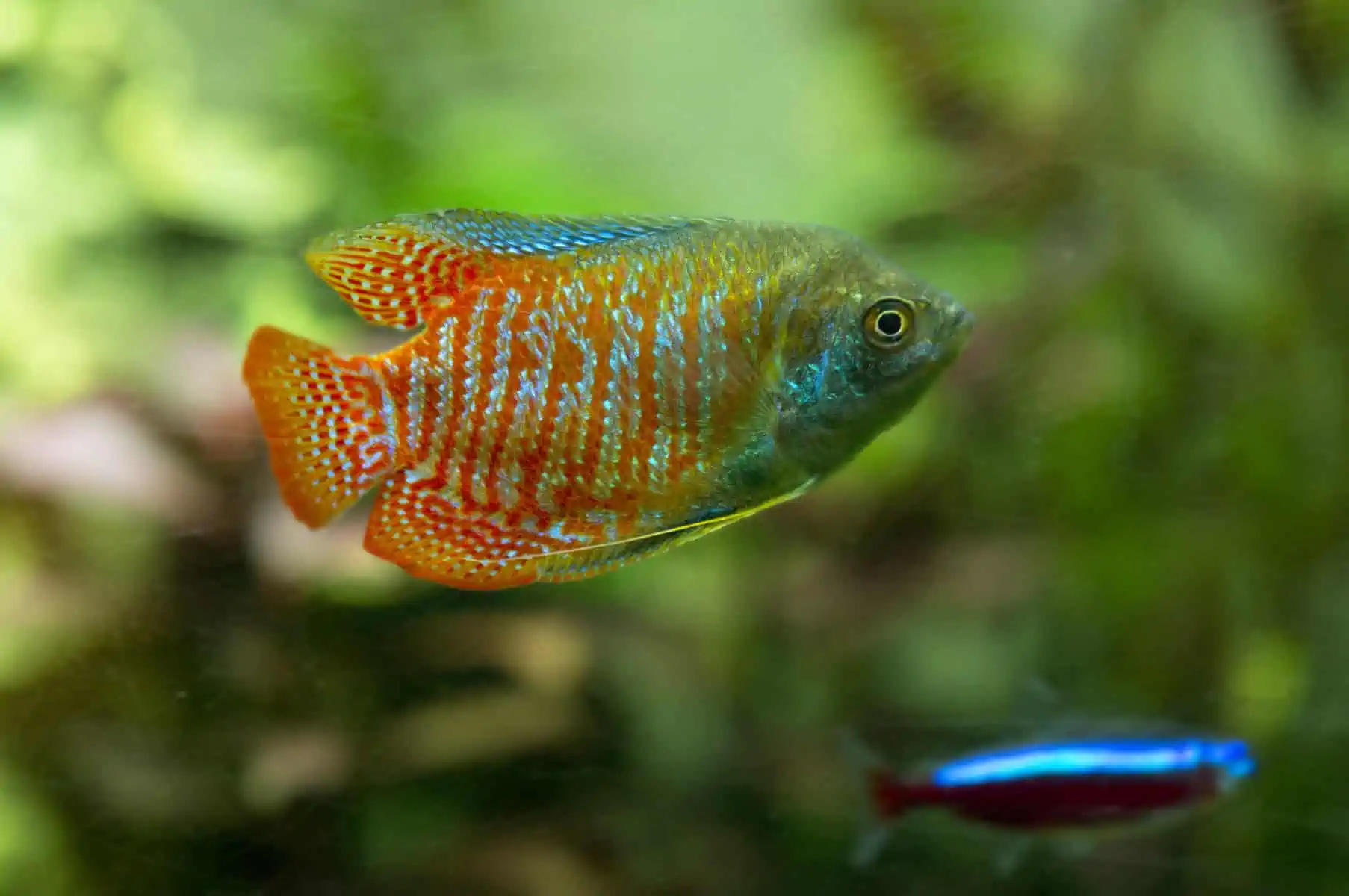
- Water temperature: 72° to 82°F
- Size: 3.5 to 4 inches
- Minimum tank size: 10 gallons
The Dwarf gourami is one of the prettiest gourami types you’ll see in the community tank. These beautiful fish come in rainbow colors with gorgeous iridescent highlights that catch the eye when the fish swim.
These fish are pretty hardy, enjoying a tank with plenty of plants and places to hide, and they’re quite tolerant of water chemistry, provided conditions remain stable.
You can keep Dwarf gouramis with other peaceful fish, such as loaches, Mollies, Corydoras catfish, and invertebrates, such as shrimp and snails.
Moonlight Gourami (Trichopodus microlepis)
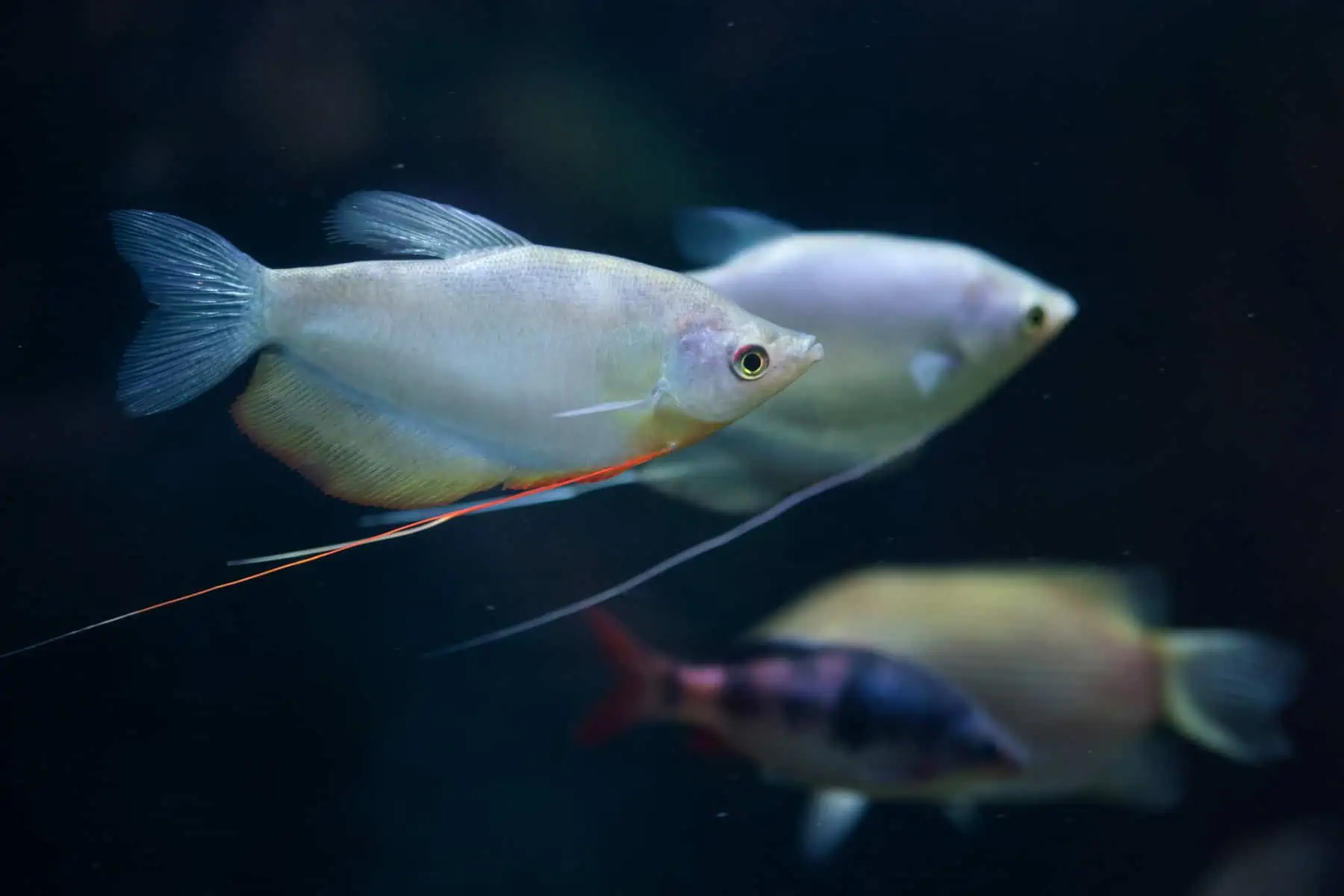
- Water temperature: 77° to 86°F
- Size: 5 inches
- Minimum tank size: 30 gallons
Moonlight gouramis are elegant, enigmatic fish that charm any aquarium, gliding through the water and displaying silver-green, iridescent colors under the lights.
Male fish display red or orange coloration near the dorsal fin and around the eyes, while females sometimes have a yellow hue.
These peaceful fish do best when kept with fish of a similar size because males can be bullies if housed with smaller fish. Moonlight gouramis enjoy a densely planted tank with a low flow rate.
Kissing Gourami (Helostoma temminckii)
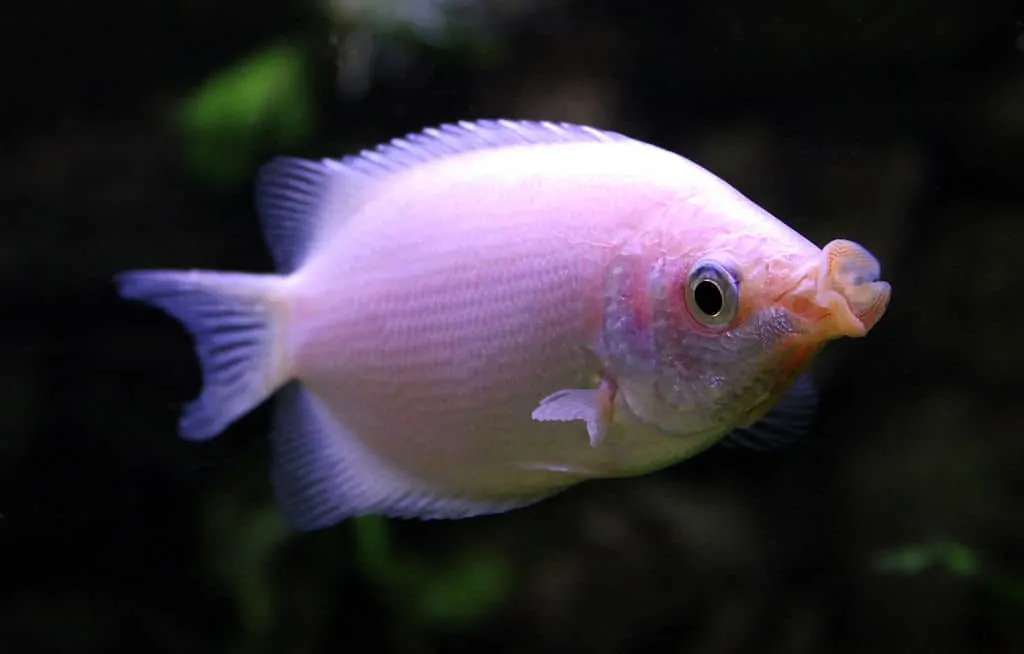
- Water temperature: 72° to 82°F
- Size: 12 inches
- Minimum tank size: 50 gallons
Kissing gouramis can be easily spotted thanks to their lips that are constantly puckered up as if waiting for a smooch!
Occasionally, you’ll see the fish apparently “kissing” each other on the lips. However, although that looks cute, it’s actually an aggressive display between male fish.
Kissing gouramis typically grow to around 12 inches long, so you’ll need a large, well-planted tank of at least 50 gallons if you want to keep them.
These fish don’t cope well with a fast flow in the tank, so you need a filter system that’s not too fierce or that can be buffered with decorations or plants.
Unlike most gouramis, these fish are regarded as being semi-aggressive, so you need to keep them with fish of a similar size and body shape.
Giant Gourami (Osphronemus goramy)
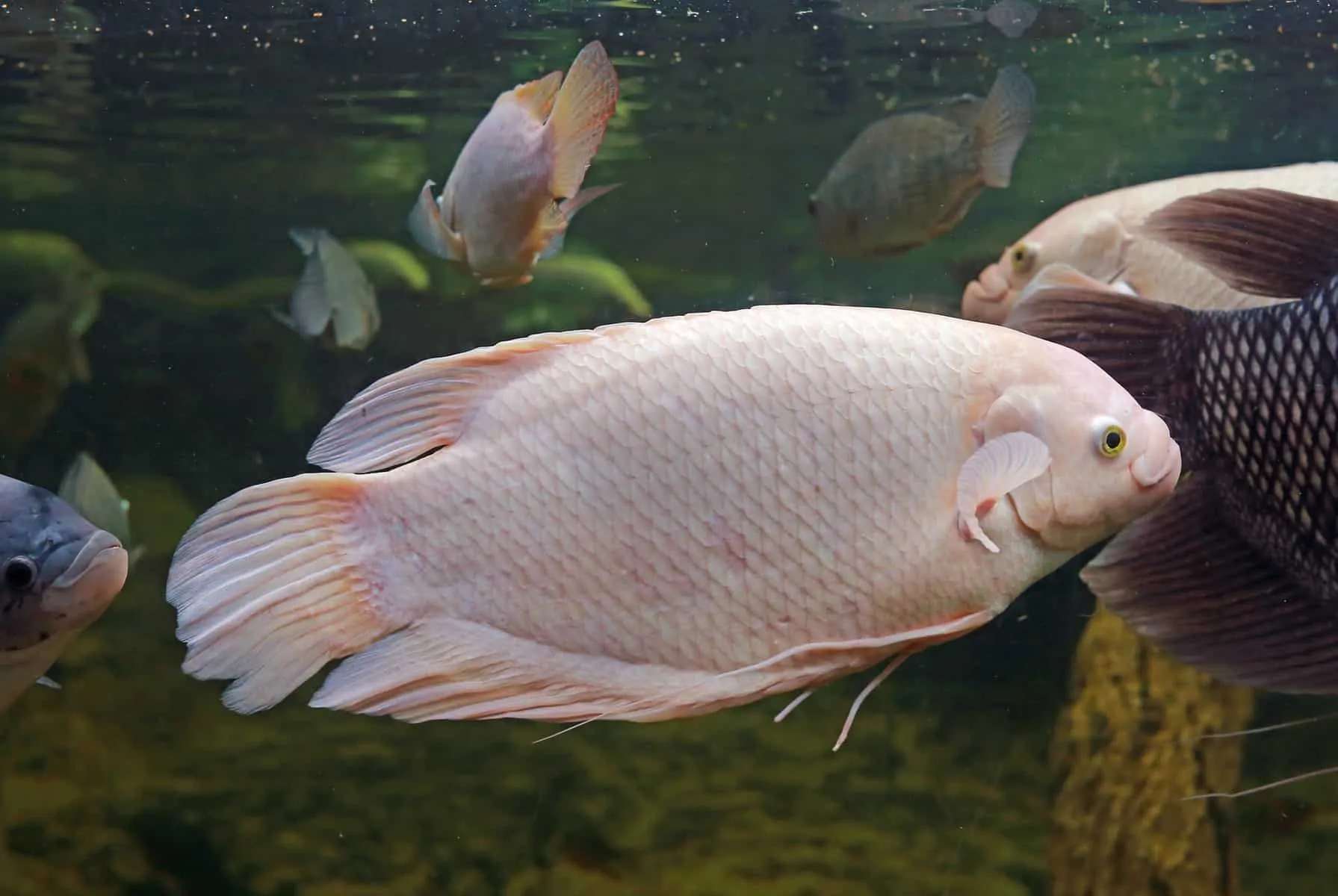
- Water temperature: 68° to 86°F
- Size: 18 to 20 inches
- Minimum tank size: 200 gallons
As you might guess from their name, the Giant gourami is one of the biggest varieties of gouramis out there. These massive fish can grow to reach 20 inches in length, although 16 to 18 inches is more common in captive fish.
The white or silver Giant gourami needs a huge tank of at least 200 gallons filled with lots of floating plants and plenty of open swimming space.
Although the species is naturally peaceful, they are not schooling fish and are usually content to be kept alone.
Giant gouramis make excellent pets, recognizing their owners and even allowing themselves to be petted!
Sparkling Gourami (Trichopsis pumila)
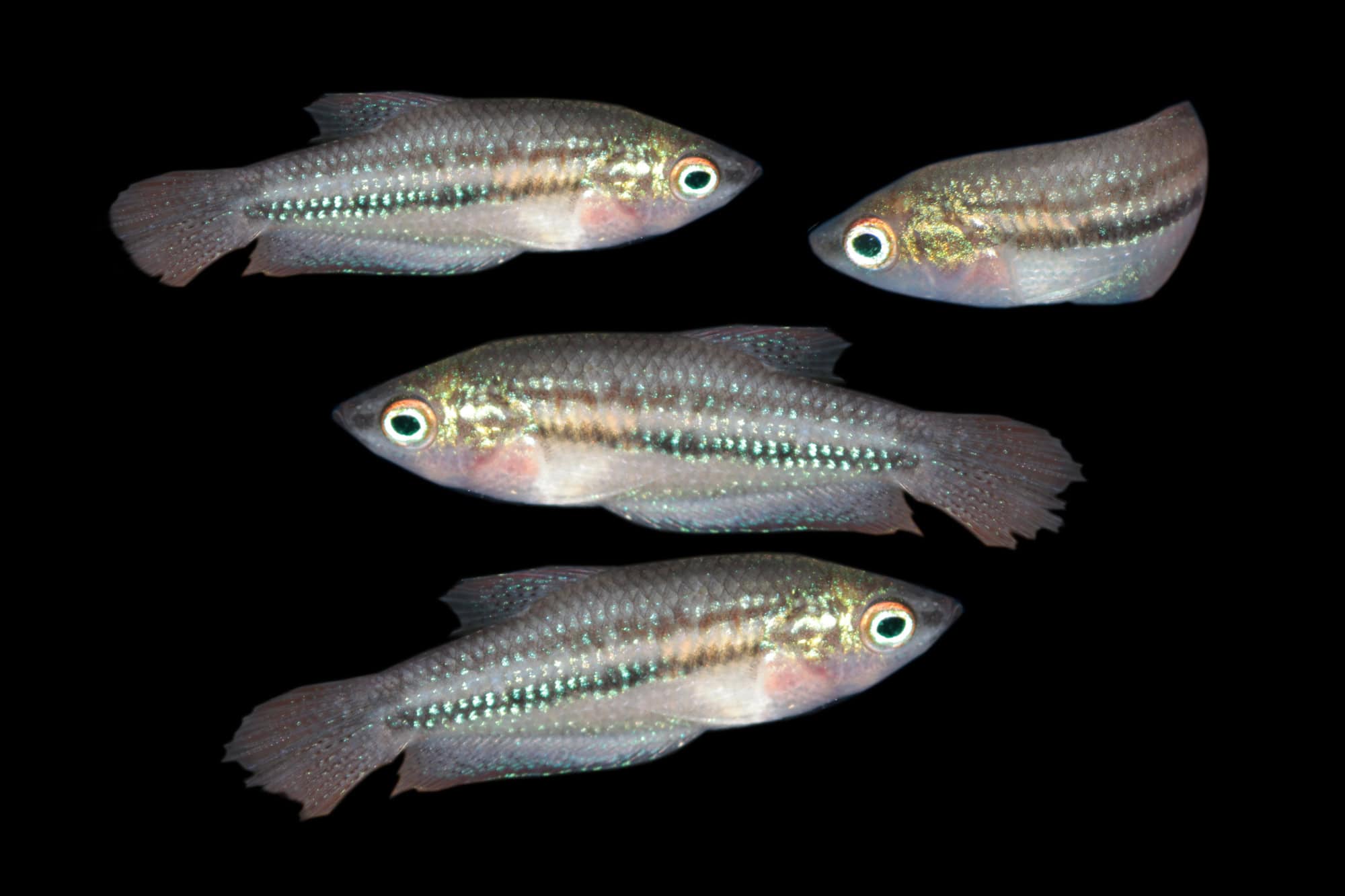
- Water temperature: 77° to 82.5°F
- Size: 1.5 inches
- Minimum tank size: 10 to 15 gallons
The Sparkling gourami is the smallest known variety of this popular fish family, usually growing to just 1.5 inches long.
These colorful, glittering fish have a more streamlined body shape than that of other gouramis, more closely resembling that of betta fish.
These fish do best when kept in groups of five or six individuals, and you’ll often hear them chirping or grunting as they go about their day.
Sparkling gouramis prefer a well-planted tank with lots of swimming space and a few peaceful tank mates, such as tetras, Corydoras, and other smaller gourami species.
Chocolate Gourami (Sphaerichthys osphromenoides)
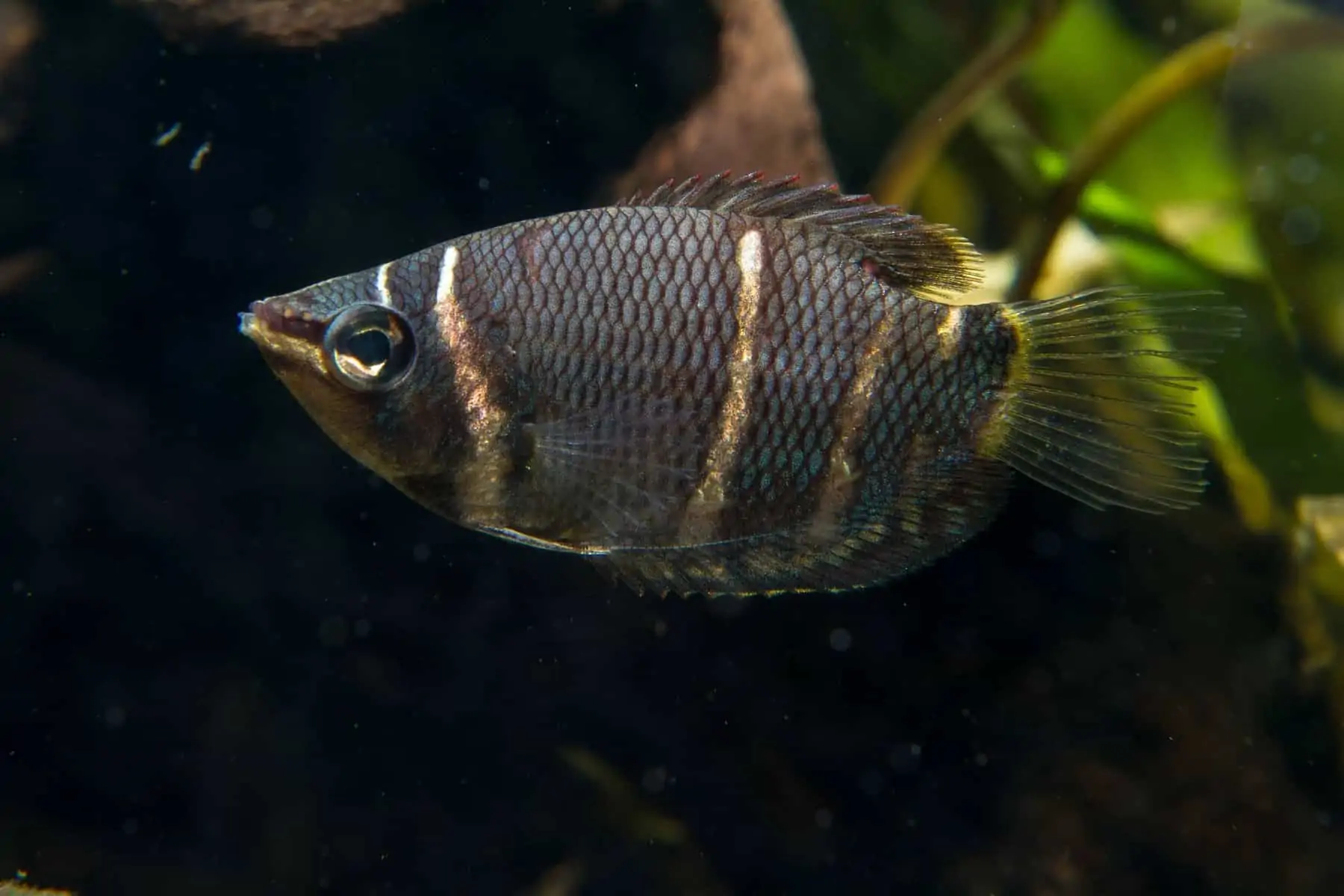
- Water temperature: 77° to 84°F
- Size: 2.4 inches
- Minimum tank size: 30 gallons
Experienced fish keepers might want to take on the challenge of keeping the gorgeous Chocolate gourami. These fish are not as hardy as other gourami varieties and can be tricky to keep healthy, preferring acidic water chemistry and tropical temperatures.
These cute little fish need a humid habitat containing lots of plants, which is not straightforward considering that these fish prefer acidic water.
Chocolate gouramis prefer to live in schools and often reject other gourami species that try to join them.
However, these fish typically get along well with other small, peaceful fish, including loaches, danios, and rasboras.
Honey Gourami (Trichogaster chuna)
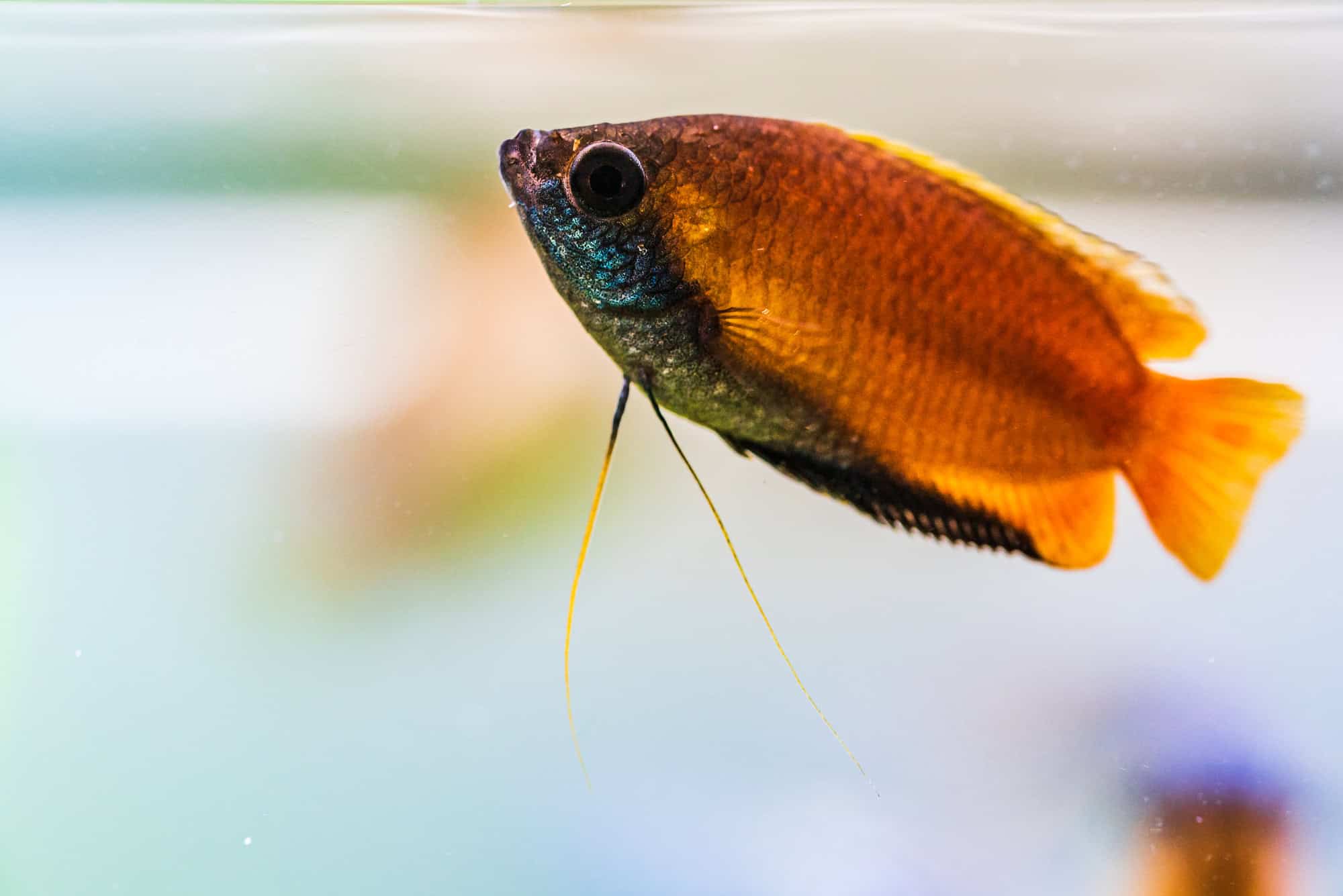
- Water temperature: 71° to 82°F
- Size: 2.2 inches
- Minimum tank size: 10 to 15 gallons
The Honey gourami is also known as the Sunset gourami, and fish stores often use the names interchangeably. However, if you look for the fish’s scientific name, Trichogaster chuna, you’ll get the right species.
These gouramis are hardy and easy to keep, making them a good choice for a beginner’s tank with plenty of dense planting and lots of open swimming space. Keep these fish in small groups with companions, including danios and Corydoras.
These fish have a novel hunting method where they float diagonally from the water’s surface, watching for a likely victim to pass by.
When the fish spots an insect hovering above the water, it squirts water at the prey to knock it down into the water, where the fish gobbles it up.
Paradise Gourami (Macropodus opercularis)
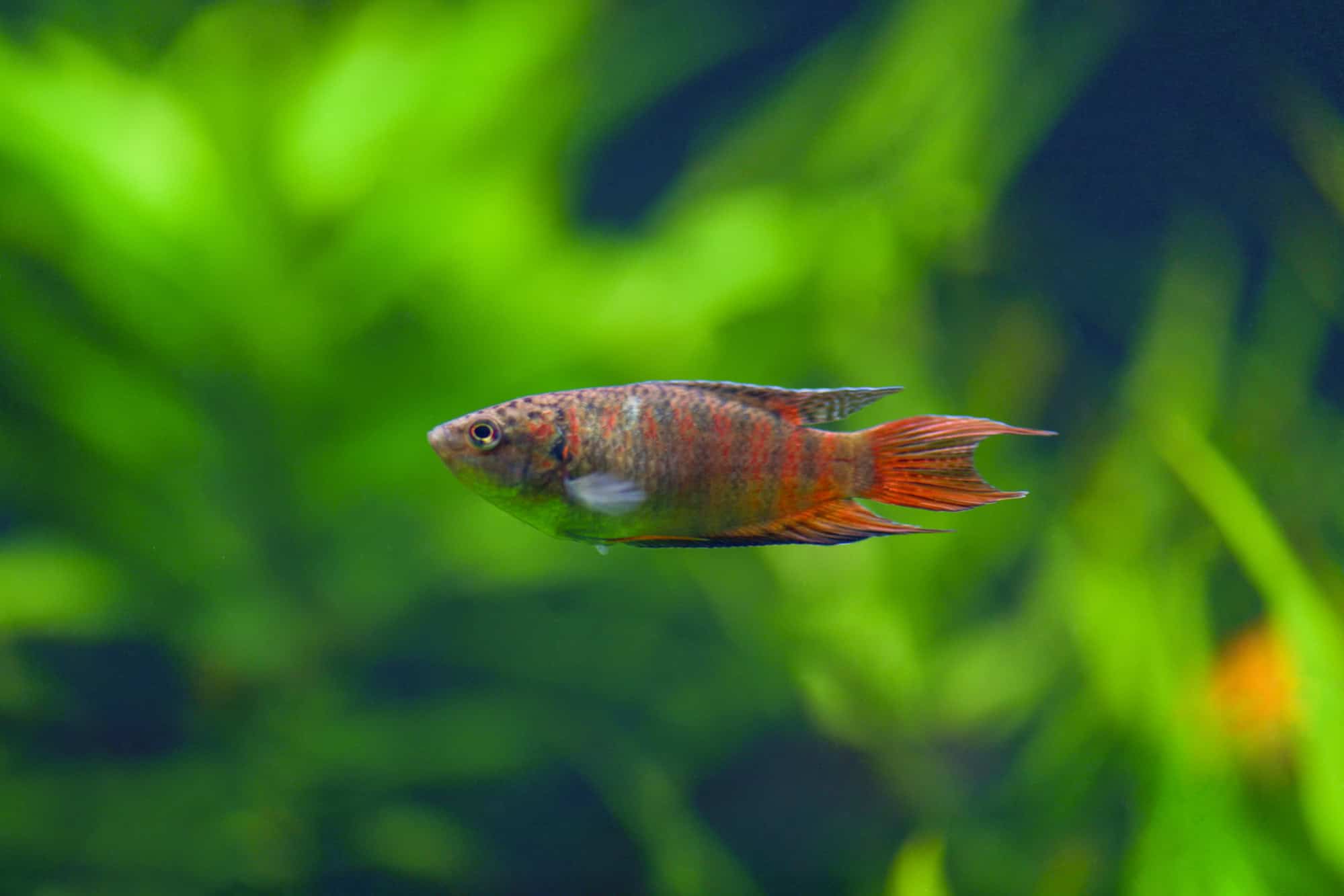
- Water temperature: 61° to 79°F
- Size: 2.5 inches
- Minimum tank size: 20 gallons
Paradise gouramis are one of the longer-living of the gourami family, surviving for up to 10 years.
Although these are undoubtedly beautiful fish with flowing fins and glorious bright stripes in the spawning season, Paradise gouramis are quite aggressive toward other gouramis.
The best tank mates for the Paradise gourami include some species of cichlids, plecs, and Clown loaches, and they can be kept with Common goldfish, too.
Licorice Gourami (Parosphromenus deissneri)
- Water temperature: 75° to 82°F
- Size: 2.5 inches
- Minimum tank size: 20 gallons
The Licorice gourami is a small gourami that’s similar in shape to the betta fish.
These small striped fish are cave spawners that do best when kept in groups in a single-species tank. However, you can keep the Licorice gourami with other peaceful fish, such as Corydoras catfish and loaches.
Blue (Three-Spot) Gourami (Trichopodus trichopterus)
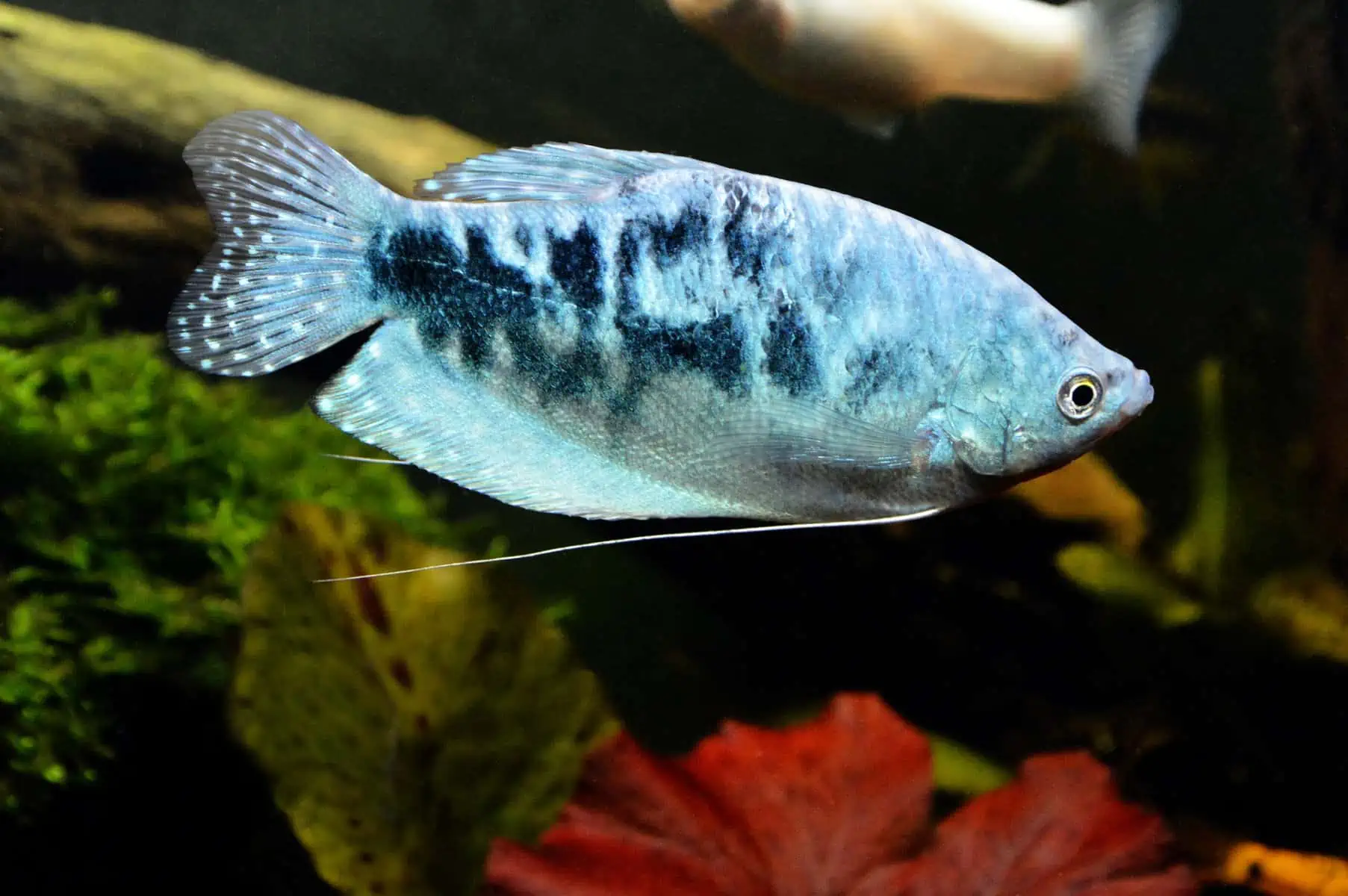
- Water temperature: 72° to 83°F
- Size: 5 inches
- Minimum tank size: 20 gallons
Blue gouramis are attractive fish that can do well in large, well-planted tanks alongside other fish of a similar size. That said, we recommend that you avoid keeping Angelfish and Dwarf gouramis with the Blue gourami.
However, you can safely keep a few Blue gouramis with Mollies, danios, and loaches.
These omnivorous fish love to snack on Hydra, making them a perfect choice if you have these pests in your aquarium.
Pearl Gourami (Trichopodus leerii)
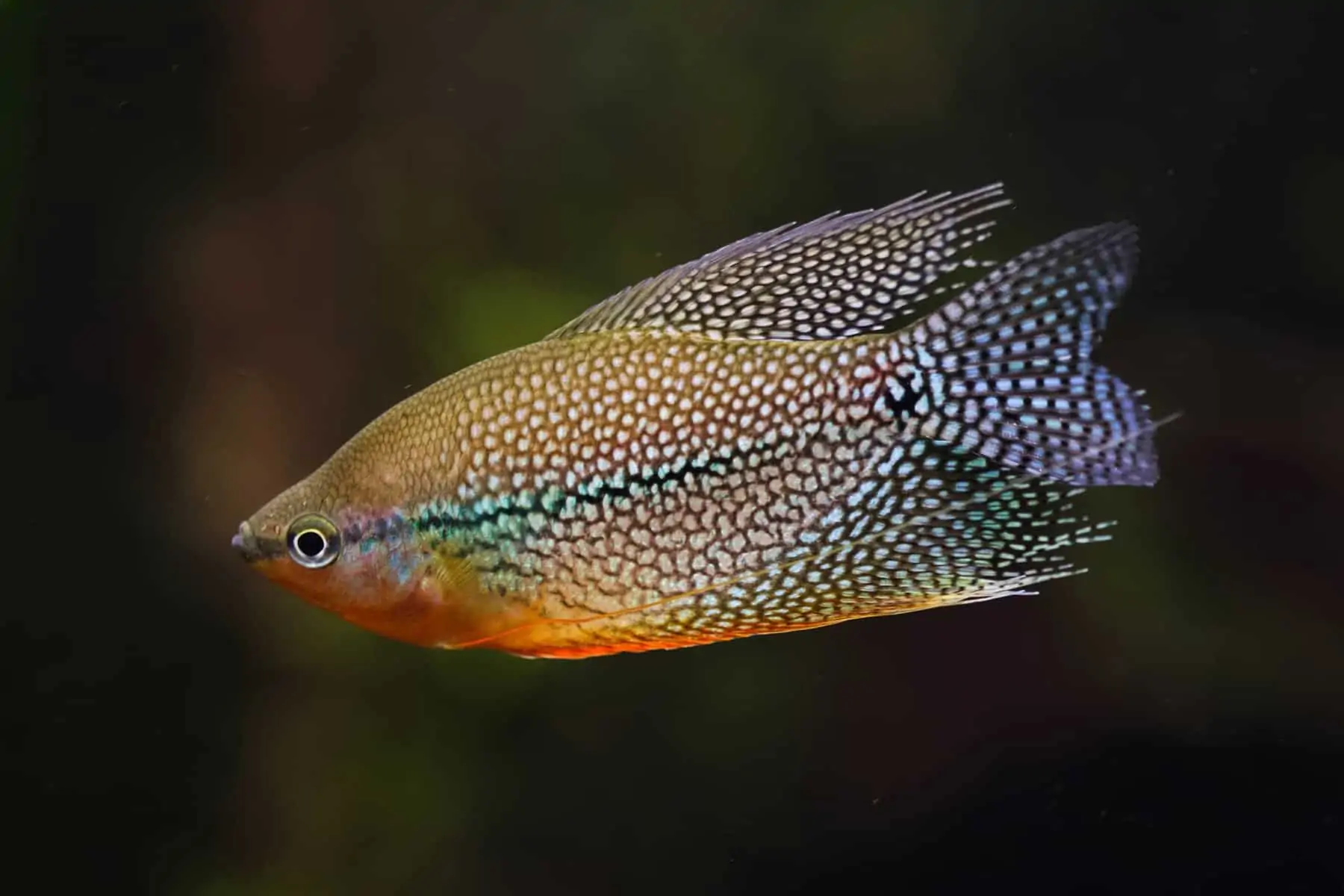
- Water temperature: 77° to 82°F
- Size: 4 to 5 inches
- Minimum tank size: 30 gallons
Pearl gouramis are beautiful fish that have the ability to vocalize, producing croaks, growls, and grunts when stressed.
These are generally peaceful fish, although males can be semi-aggressive toward each other when spawning. To keep a peaceful community, it’s best to include similar-sized, peaceful tank mates and have just one male in a group of Pearl gouramis.
Like betta fish, these gouramis are bubble nesters, and you’ll often see males creating clumps of bubbles at the water’s surface, usually under the leaves of floating plants.
Snakeskin Gourami (Trichopodus pectoralis)
- Water temperature: 72° to 86°F
- Size: up to 8 inches
- Minimum tank size: 20 gallons
Snakeskin gouramis can grow up to 8 inches long and have a lifespan of around six years.
Like most of the other gourami varieties, Snakeskin gouramis prefer a well-planted tank that has plenty of swimming space and floating plants.
These large fish are peaceful, and you can safely keep them with barbs, Corydoras, and loaches. However, Snakeskin gouramis are meat eaters, and they will prey on very small fish if given the opportunity.
Overstocking can also cause the Snakeskin gourami to become aggressive if it has to compete for space or food.
Samurai Gourami (Sphaerichthys vaillanti)
- Water temperature: 70° to 80°F
- Size: up to 2.2 inches
- Minimum tank size: 20 to 30 gallons
Samurai gouramis enjoy acidic water conditions with a low nutrient and mineral content, which makes setting up a suitable habitat rather challenging since these gouramis are shy and prefer a densely planted tank.
In addition, wild Samurai gouramis live in a blackwater environment, so you might need to add Indian Almond leaves to your aquarium to create that habitat.
In this species of gourami, it’s the females who rule the roost, bossing the males! But both sexes are shy creatures, so you’ll need to provide them with plenty of hiding places and dense planting.
Samurai gouramis are unusual because they are one of the few gourami species that are mouth brooders rather than bubble nest builders.
Once the female has laid her eggs, the male collects them and carries them in his mouth until the eggs hatch. That can take anything up to three weeks, and the poor male gourami can’t feed throughout that time – amazing!
Opaline Gourami (Trichopodus trichopterus)
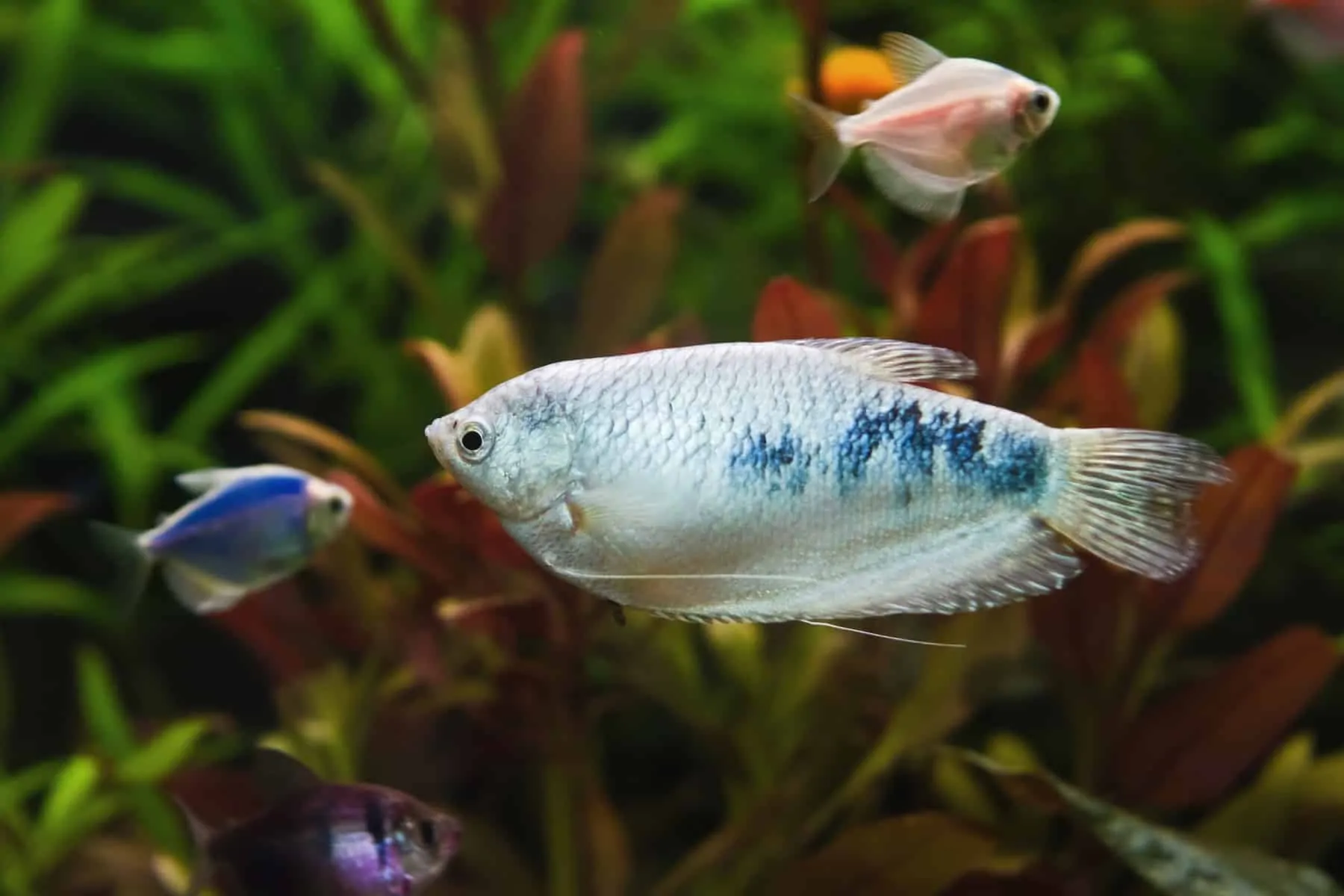
- Water temperature: 72° to 83°F
- Size: up to 4 to 6 inches
- Minimum tank size: 20 gallons
Opaline gouramis are essentially another color variation of Blue gouramis.
Like the other types of this gourami species, males can be semi-aggressive if kept in mixed groups, and their belligerence increases with age.
These fish can live for up to seven years if provided with a well-maintained, well-planted tank that offers plenty of swimming space.
Powder Blue Gourami (Trichogaster lalius)
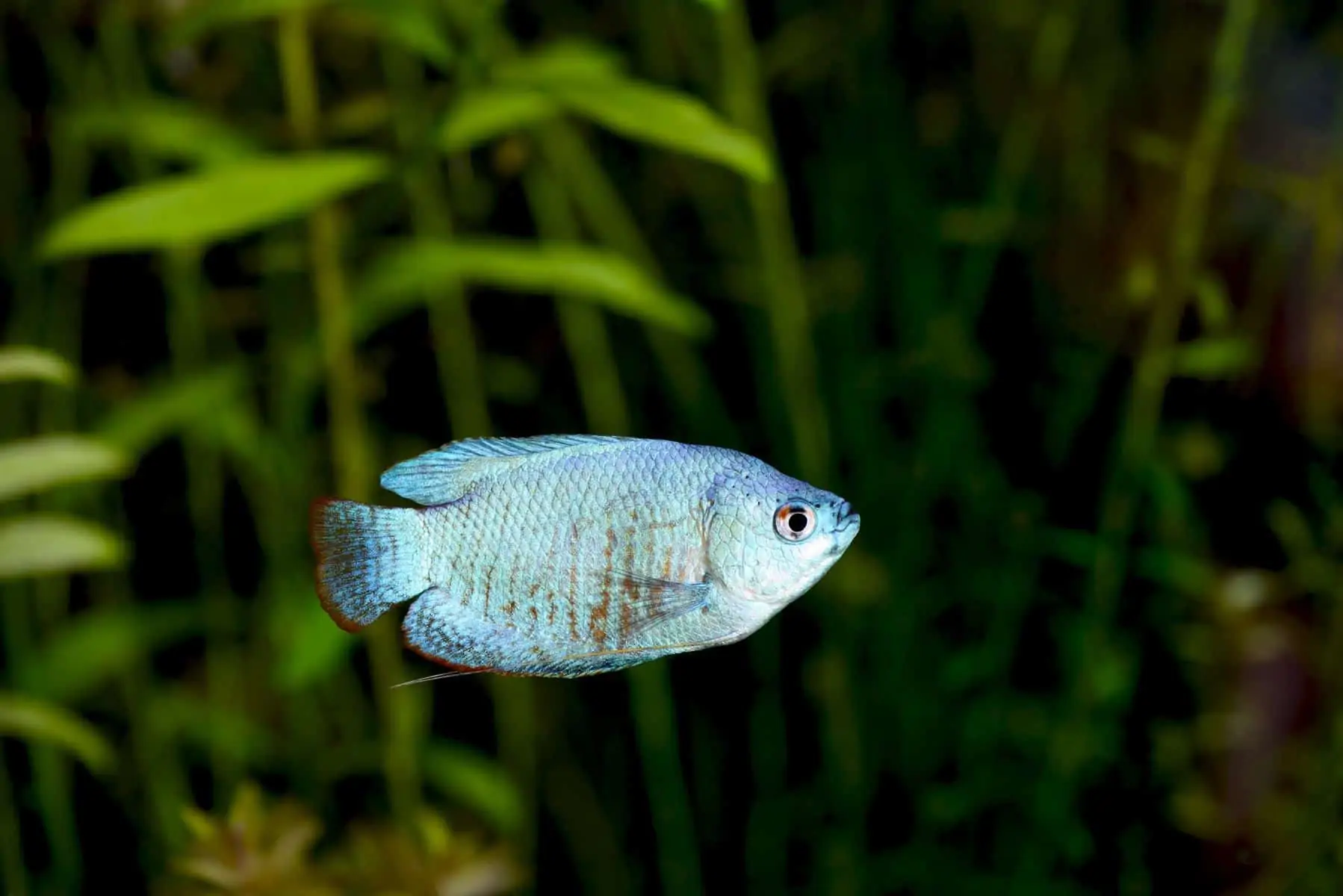
- Water temperature: 72° to 82°F
- Size: up to 3 to 5 inches
- Minimum tank size: 10 gallons
Powder Blue gouramis are one of my favorite fish!
These fish don’t grow too big, live for around seven years, and are generally peaceful. But the most wonderful thing about the Powder Blue gourami is its glorious, metallic solid blue coloration.
Many beginners start off with a few Powder Blue gouramis in their community setup since these fish are pretty easy to care for and mix well with many other popular species, such as Corydoras, loaches, Rainbowfish, and tetras.
Gold Gourami (Trichopodus trichopterus)
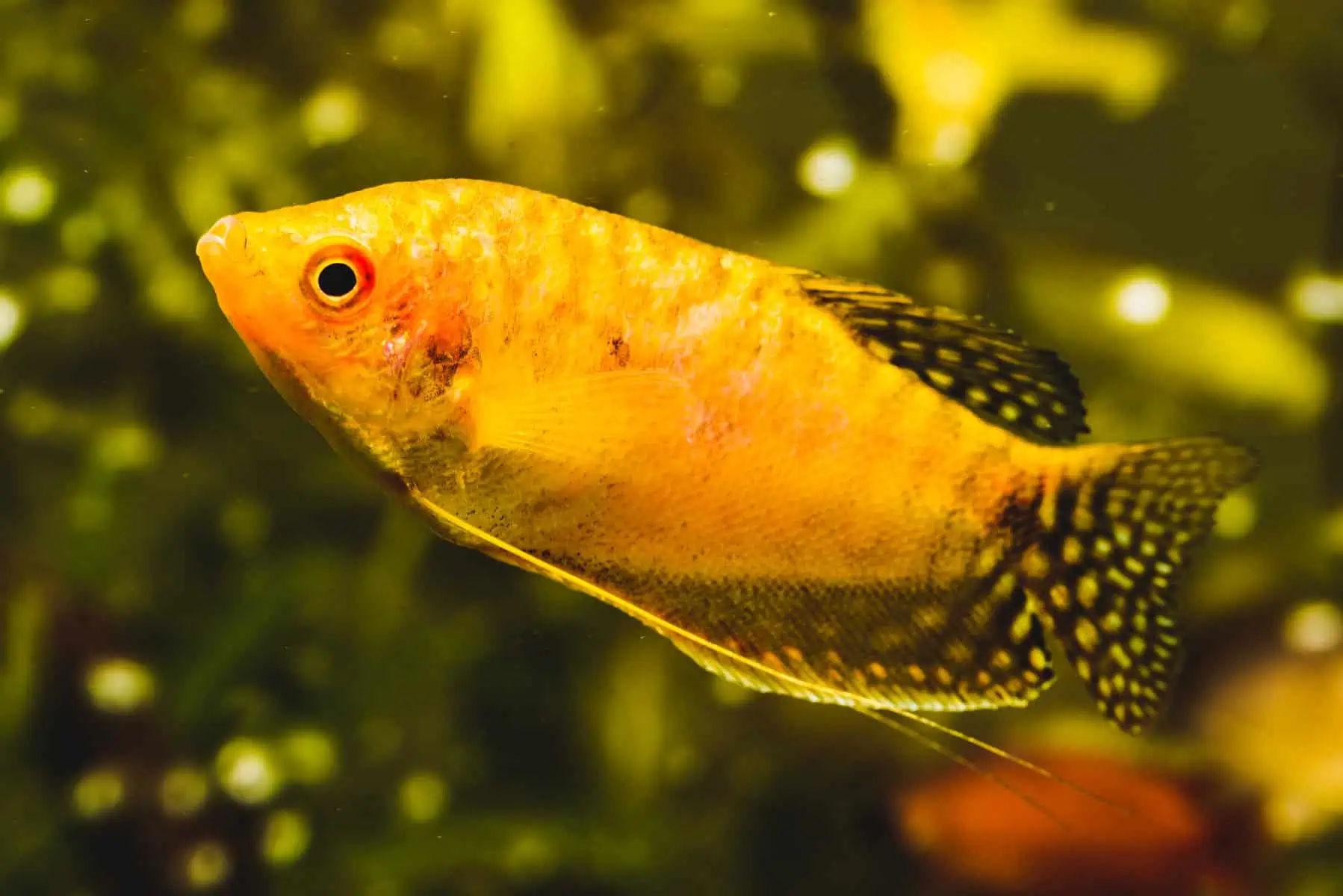
- Water temperature: 73° to 82°F
- Size: up to 6 inches
- Minimum tank size: 35 gallons
The gorgeous Gold gourami is another favorite fish of mine. These fish are another color morph of the Blue or Three-Spot gourami, so they have very similar care requirements.
Gold gouramis are large fish, growing up to around 5 inches long, and can live for around five years when given proper care.
If the fish become stressed, their color can fade, so you’ll need to provide a well-planted tank with plenty of swimming space for these labyrinth fish.
Thick-Lipped Gourami (Trichogaster labiosa)
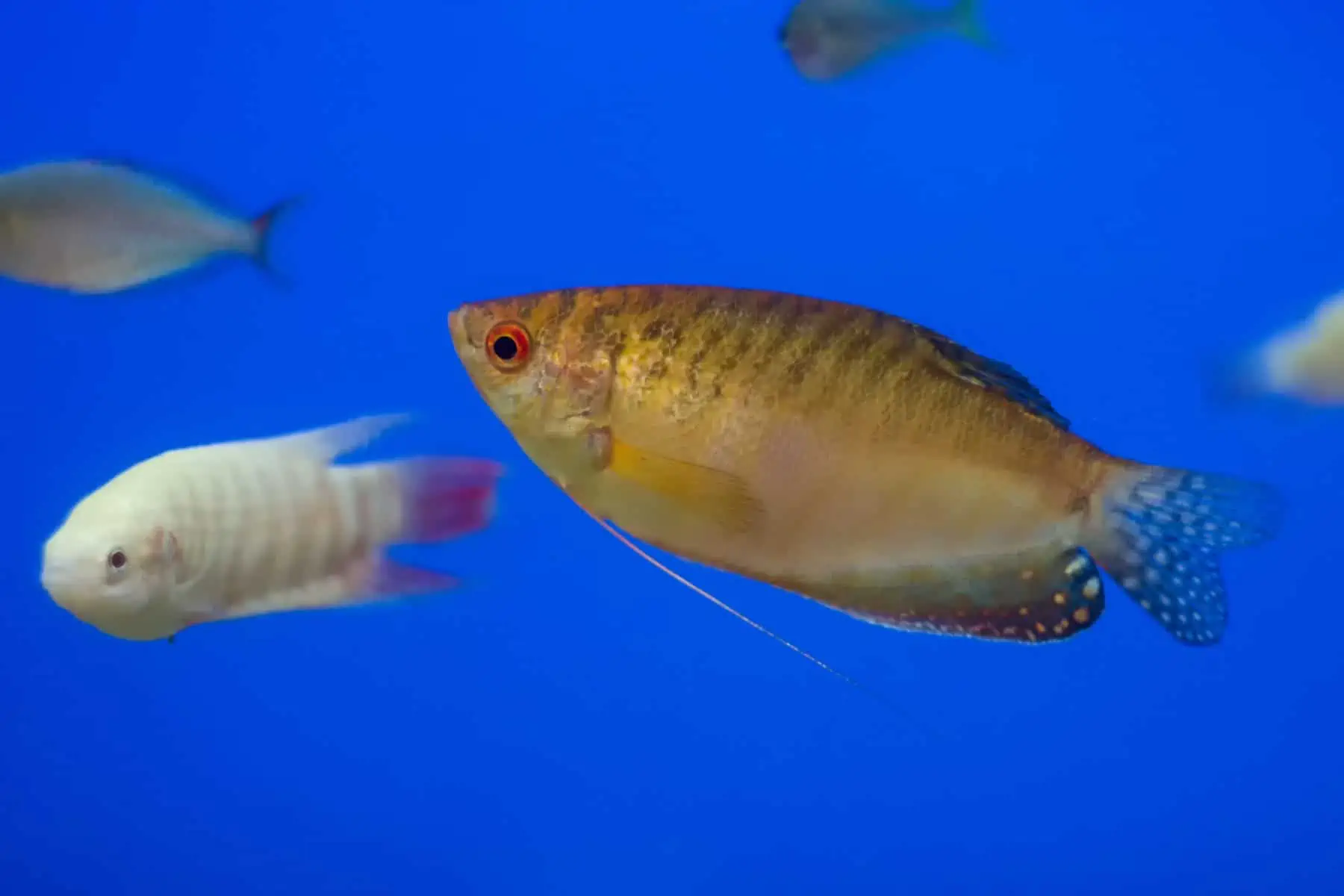
- Water temperature: 72° to 82°F
- Size: up to 4 inches
- Minimum tank size: 20 gallons
You probably won’t find Thick-Lipped gouramis in your local fish store, although they are often available through online breeders.
These fish are hardy, peaceful, and easy to keep, making them an excellent choice for beginner aquarists.
Thick-lipped gouramis are one of the longer-lived varieties, often reaching eight years of age if kept in tanks with plenty of swimming space, plants, and peaceful tank mates.
Thick-Lipped gouramis are one of the most vibrant gourami varieties, and their rainbow of colors adds a glorious pop of color to any tank.
Betta Fish (Betta splendens)
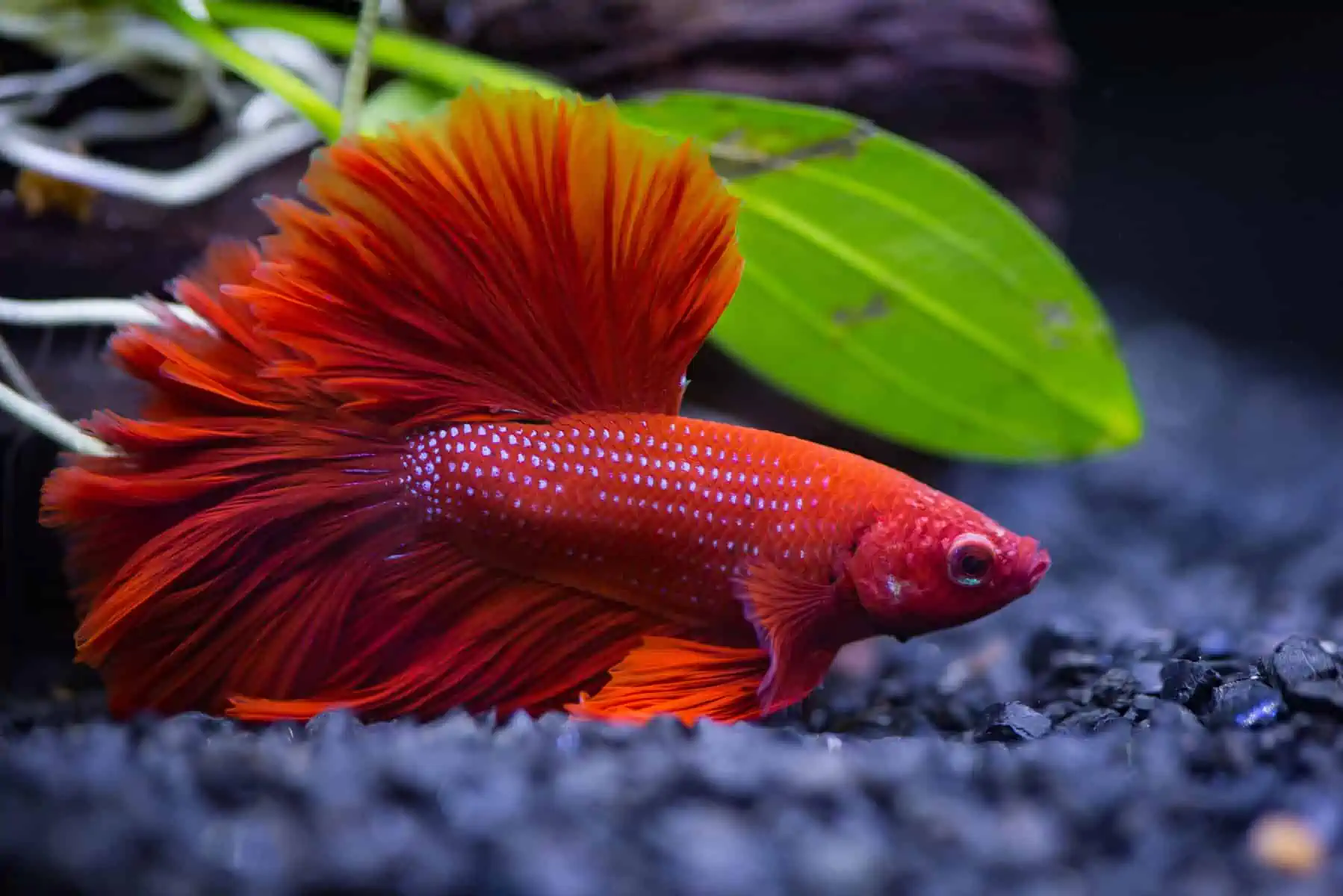
- Water temperature: 75° to 80°F
- Size: up to 3 inches
- Minimum tank size: 5 gallons
Okay, so betta fishes are not actually a gourami but a separate species. However, as mentioned previously, bettas and gouramis are both labyrinth fishes, so we’ve included them here.
Unlike gouramis, male bettas are aggressive fishes that cannot live together without fighting, often to the death!
However, you can keep most male betta fish with peaceful, similar-sized fish that will steer clear of the upper areas of the water column where the betta makes his territory.
Bettas come in a dazzling array of beautiful colors and tail forms and are easy to care for.
In fact, you can train your betta fish to perform simple tricks, and many owners vouch for their betta’s friendliness and intelligence.
Banded Gourami (Trichogaster fasciata)
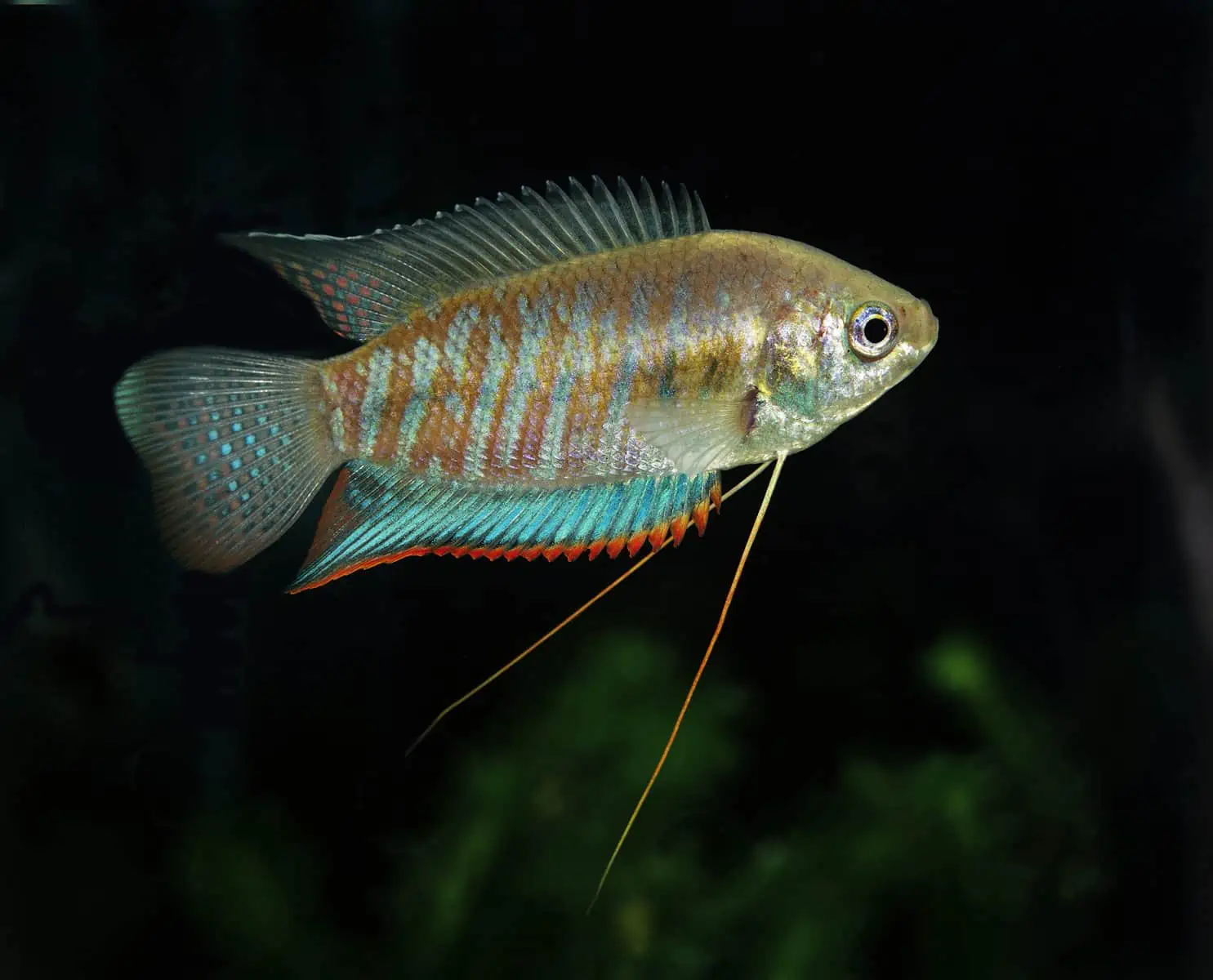
- Water temperature: 70° to 82°F
- Size: up to 4 inches
- Minimum tank size: 30 gallons
This unusual gourami fish species originates from certain regions in India and is a relatively unusual sight in the hobby.
The Banded gourami is seldom seen in pet stores, so you’ll need to get yours from an online breeder.
That’s a shame, as these are truly beautiful fish that are easy to care for and can be encouraged to breed in the home tank.
These are shy fish that need a heavily-planted tank in a quiet area of your home. However, they’re peaceful characters that can get along well with tank mates of a similar size and disposition.
Croaking Gourami (Trichopsis vittata)
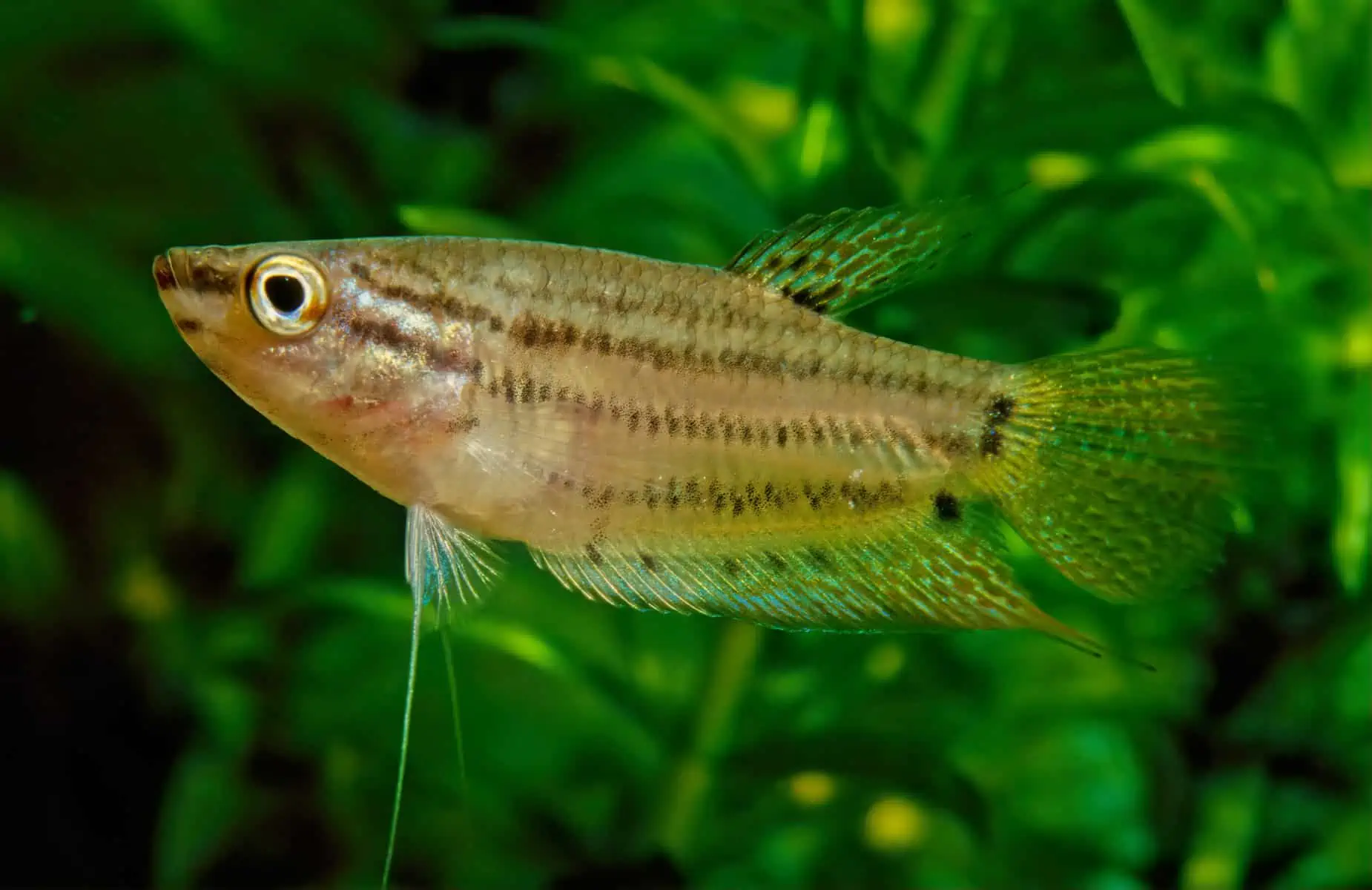
- Water temperature: 70° to 82°F
- Size: up to 3 inches
- Minimum tank size: 10 gallons
If you want a fish that talks, you might want to consider keeping the cylindrical-shaped croaking gourami fish.
These shy fish can live in a community tank with other small, peaceful species and are relatively straightforward to care for.
So, where does the Croaking gourami get its common name from?
Well, Croaking gouramis are bubble nesters, and the vocalization you hear happens when the male fish is courting a female, usually underneath his bubble nest.
These fish reproduce pretty readily and breeding them in a separate spawning tank can make a fascinating project.
Final Thoughts
Did you enjoy our guide to the different gourami fish types you can keep in your community aquarium? If you did, please share the article!
There are so many varieties of gourami to choose from that it’s difficult to know where to begin!
I personally love the marbled pattern of the Opaline gourami and the brilliant, iridescent blue of the Powder Blue gourami, but the choice is yours!
Although gouramis are generally relatively straightforward to care for, males do have aggressive tendencies when kept in a mixed group, so it’s best to keep just one male with a group of females.
That said, these fish can make excellent candidates for life in a community tank with peaceful, similar-sized fish.
Do you keep gouramis? What species do you have? Tell us in the comments box below.

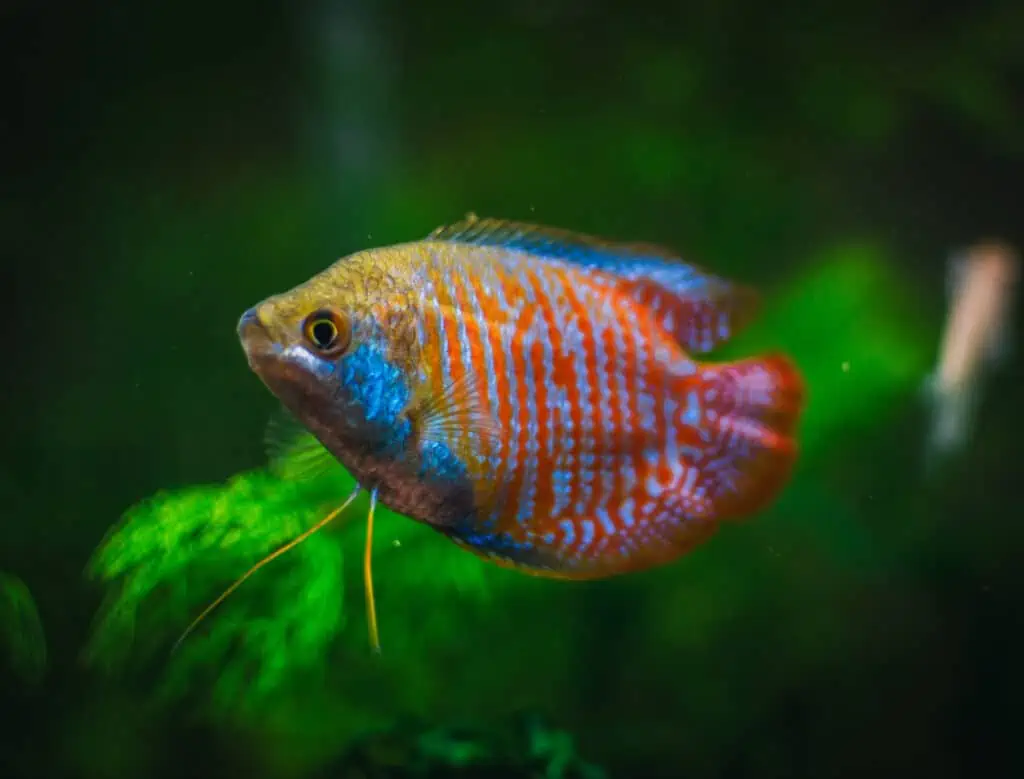

I’ve just restarted my ten gallon tank after losing four danios in a move. I’m looking into gourami to make home in the newly empty tank. I’d really like to have a pair (one male powder blue dwarf gourami and a male red fire dwarf gourami) in the ten gallon but I’ve heard that the males would get aggressive. I’ve also heard though that if they’re rather peaceful and would swim together. Should I just go with one, or would the pair swim nicely together?
As discussed in this article, I unfortunately wouldn’t recommend keeping dwarf gourami in a 10 gallon tank. And definitely not two males! How do you feel about the sparkling gourami (Trichopsis pumila)? A male/female pair of those is a joy to watch and will do much better in a 10 gal. They’re very colorful and a joy to watch 🙂
Good luck!
Sounds like a lovely pair but I don’t think my local Petsmart has sparkling gourami. Thanks again for the help! I think I’m just going to get the one dwarf and see how he does.
Hi,
I really urge you to decide against the dwarf gourami, even if you get only one. Their minimum tank size is just larger than a 10 gallon and there’s not really a way around that. You can try ordering sparkling gourami online or, if that’s not an option, please choose another fish species. I know it’s a bummer when you can’t keep the fish you’d like to, but that’s unfortunately just the way things work in the aquarium world.
Sorry to keep bugging you about the dwarf gourami I seemed to have missed this comment. Well, I think I am going to look for a different specie. I left another comment on the cherry shrimp before I read this last comment, just ignore that one.
If you are really into gouramis, you could check “paradise gouramis” as a potential choice for your tanks. They can do really well in hard water and unheated tanks. Check them out, the scientific name is”Macropodus opercularis”.
You are entirely right! I couldn’t fit all the beautiful species of gourami on this list and this is definitely one that is also deserving of checking out. A great option for unheated tanks. Thanks for the tip 🙂
which gourami, if any, would be best in a large tank (~80 g) with about 20 rasboras and cardinal tetras in aggregate, two mid size (6″ tall) angelfish, and a pair of six inch twig catfish?
I’m not a huge fan of gouramis and angelfish together! There is no guarantee whether it will go right or wrong. You’re usually best off keeping angels as the only “predators”.
I would love to have a Gourami sp. but my tanks are unheated by choice, and my local water is certainly not soft. Too bad, such beautiful fish.
Gregg